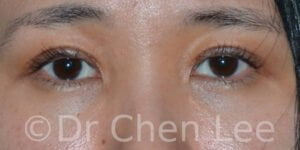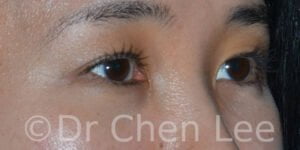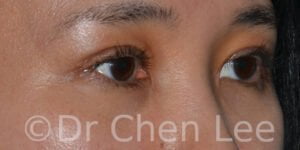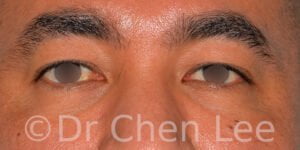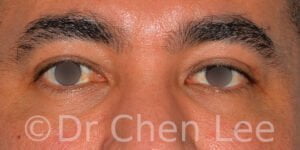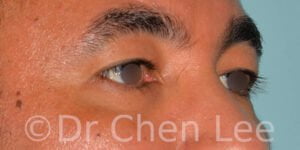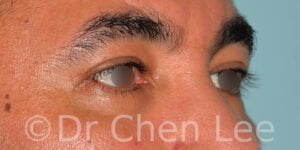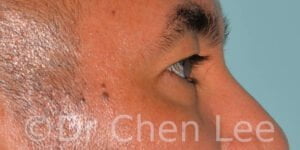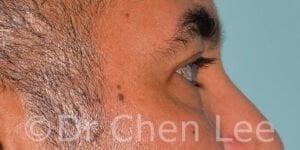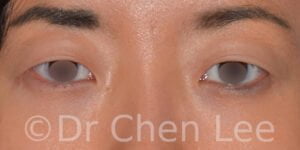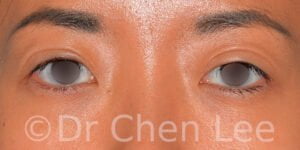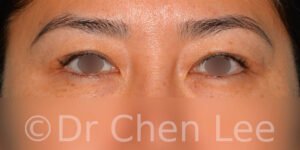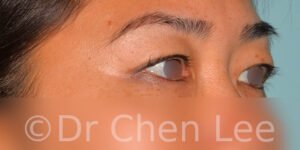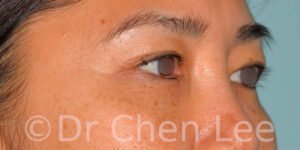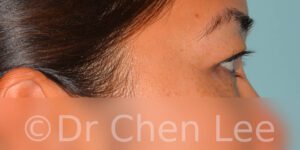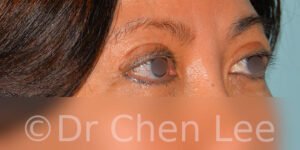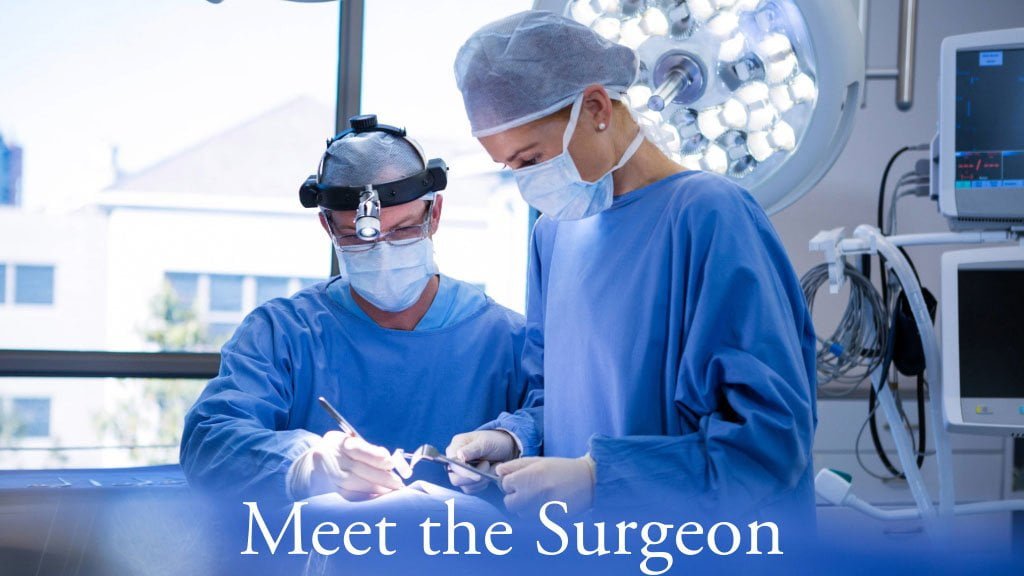Asian Blepharoplasty | Double Eyelid Surgery
Asian eyelid surgery in Montreal
Asian eyelids have specific anatomical features. In fact, almost half of the Asian population does not have a crease in the upper eyelid. Doctor Chen Lee, a board certified plastic surgeon, is available to perform your Asian eyelid surgery in Montreal.
Asian eyelid surgery can also help improve vision in elderly patients who have excess skin on their upper eyelids. Although a blepharoplasty can add a crease to the upper eyelid of the Asian eyelid, this surgery does not erase the ethnic identity.
Asian Blepharoplasty – The Essentials
During your consultation about your eyelids, we will talk to you about the techniques, the possible complications, the convalescence as well as the financing.
Types & Techniques

Asian eyelid surgery is a common operation. The majority of patients of Asian origin do not have a crease in the upper eyelids.
The absent lid crease results from an altered attachment of the levator muscle of the upper eyelid. The insertion is either absent or very low on the cartilage called the tarsus. Additionally, two other anatomical differences may contribute to the absent crease seen in the Asian eyelid. Eyelid skin laxity and malpositioning of the upper eyelid fat.
Double eyelid crease surgery does not transform the Asian eyelid into a Caucasian eyelid. The surgery opens the contours of the Asian eyelid while retaining its ethnic origins.
Asian eyelid surgery for aesthetic purposes was first described in 1896. Many named variations of the technique have evolved:
- Double eyelid surgery
- Asian blepharoplasty
- Asian eyelid surgery
- Anchor blepharoplasty
Surgical creation of a double eyelid crease consists of techniques to 1) anchor the levator aponeurosis 2) excision of excess skin 3) excision or repositioning of the malpositioned pretarsal fat (between the eyelashes and the eyelid fold).
The resulting surgical scar is hidden in the crease of the eyelid and imperceptible.
The full incision technique of Asian double eyelid crease surgery provides surgical access to 1) anchor the levator aponeurosis 2) excise excess skin 3) excise or reposition the malpositioned pretarsal fat.
Full Incision Double Eyelid Surgery
A full incision double eyelid procedure uses a horizontal incision along the entire width of the upper groove. It provided excellent access to treat malpositioned pretarsal fat and excess skin at the same time. The wide access permits precise placement of sutures to anchor the levator aponeurosis.
Am I a candidate for full incision double eyelid surgery?
Full incision double eyelid surgery is the most versatile and popular technique. More precise crease anchorage and fixation yields a more stylized upper eyelid crease with better eyelash rotation. The scar is hidden in the freshly created eyelid crease and often not visible in the long run.
The mini-incision technique of Asian double eyelid crease surgery provides limited surgical access to 1) anchor the levator aponeurosis 2) excise excess skin 3) excise or reposition the malpositioned pretarsal fat.
Mini-Incision Double Eyelid Surgery
A 1 cm incision is made in the future upper eyelid groove, allowing the creation of a new eyelid crease by anchorage of the levator aponeurosis. Anchorage can be supplemented by 2 to 5 more incisions of 2 mm to enhance the suture anchorage of the levator aponeurosis. Only limited quantities of excess skin and fat can be treated with the mini-incision technique.
Am I a candidate for mini-incision double eyelid surgery?
The mini-incision technique is useful only in patients who have minimal skin and fat excess. Furthermore, the full incision technique yields better long-term results than the mini-incision technique.
A percutaneous “double eyelid” procedure has been described to suture anchor of the skin, levator, and tarsus.
Percutaneous Double Eyelid Surgery
3-5 points of anchorage points are designed along the path of a planned upper eyelid crease. Needlepoint puncture incisions are used to place non-resorbable sutures to anchor all layers of the eyelid.
Am I a candidate for percutaneous double eyelid surgery?
Percutaneous double eyelid surgery can be considered in the small subgroup of Asian patients with no skin or fat excess. It is the least durable of the described techniques. The newly formed upper eyelid crease relies on the integrity of the anchoring sutures. Loss of the crease is most commonly a result of suture failure. Furthermore, skin and fat cannot be managed with this technique.
Blepharoplasty Considerations

During your consultation, Dr. Chen Lee will perform a detailed clinical examination to determine the best Asian blepharoplasty technique for your unique anatomy. A written detailed list of risks and complications will be provided. We encourage you to read it.
If you wish to pursue surgery, our office staff with work to reserve a date for the procedure.
Below are some basic recommendations to prepare for eyelid surgery:
- 2 weeks before surgery avoid the use of nonsteroidal anti-inflammatory medications (eg. Aspirin, Advil, Motrin, etc.)
- In the evening and morning before surgery, shower with an acne soap such as Spectro-Jel
- Do not apply facial cream or make-up on the day of surgery
Asian blepharoplasty patients are usually managed as ambulatory day surgery patients. The procedure is usually performed under local anesthesia. General anesthesia can be considered when Asian double eyelid surgery is combined with other cosmetic procedures.
A blepharoplasty procedure typically requires 1 to 2 hours to perform. Convalescence lasts 10 to 14 days.
Dr. Chen Lee regularly performs this procedure at the Metropolitan Surgery Center in Montreal. Surgeries commence early in the morning and patients are discharged in the afternoon. To prepare for surgery, experienced medical staff will greet you and review a medical checklist to ensure a safe surgery.
Following surgery:
- You must be accompanied home by a trusted friend or family member.
- We recommend that they be present in your home for the early days after surgery.
Our office will call by telephone to periodically check on your progress at home. Your first follow-up appointment will take place approximately 6 to 10 days later.
- To reduce swelling, try to maintain a sitting or semi-sitting position.
- Cool compresses applied to the eyelids reduce discomfort. Refrigerated saline solution can be used to cool and moisten the eyelid compresses.
- Take medications as prescribed.
- Maintain the Steri-Strips in place until your doctor removes them.
Contact us immediately if:
- Bleeding
- Intense pain
- Fever
Complications following a properly performed blepharoplasty are infrequent. Despite the low frequency, it is important to be aware and informed of the possible complications.
Infection: Most eyelid infections following blepharoplasty result from suture entry points. Micro abscesses can develop around the break in the skin around the suture points. This complication responds well to local wound care.
Scars: The thin skin of the eyelid usually heals very well. While unusual, it is possible for the scars to be visible and less subtle than desired.
Epidermal cysts: These can appear where the incision is placed. They will often resolve spontaneously. Persistent cysts may require excision with a subsequent minor procedure.
Epiphora: Persistent tearing is known as epiphora. This occurs more often in patients who have “dry eye” syndrome. Treatment consists of protection and lubrication of the ocular globe until the normal tear film is restored.
Lagophthalmos: The inability to completely close the eyelids is called lagophthalmos. This is possible in the early days after the blepharoplasty. It spontaneously resolves in the following weeks after surgery.
Ectropion: Retraction of the lower eyelid is known as ectropion. Severe retraction is uncommon following blepharoplasty. The minor ectropion may present as rounding of the form eyes and is more often observed in patients with preexisting laxity to the lower eyelids. Poorly tone of a lower eyelid may result in its eversion from the force of a healing blepharoplasty incision. It often will improve as the scars mature. Gentle lower eyelid massage aids in scar relaxation and is used to manage ectropion following blepharoplasty.
Retrobulbar hematoma: Blood accumulation behind the ocular globe is known as a retrobulbar hematoma. Pressure from a retrobulbar hematoma impairs the vascular circulation to the optic nerve and can result in blindness. It is a known but rare complication following blepharoplasty.
Financing & Convalescence

At the initial office consultation for Asian double eyelid surgery, Dr. Chen Lee performs a thorough examination to tailor his recommended treatment to an individual’s unique anatomy. He may use before and after photos of previous cases to explain procedures and demonstrate possible outcomes. In addition, the risks associated with the recommended treatment will be explained in detail.
The price of Asian blepharoplasty in Montreal is quoted as a “global fee”. The price quote includes the costs of the surgeon, anesthesiologist, nurses, office visits during the first post-operative year, operating room, and surgical facility fees. Revisions and touch-up surgeries are not included in the initial eyelid surgery quotation. If general anesthesia is necessary, you will have to pay for the substantial costs associated with a surgical revision. Minor touch-up surgery under local anesthesia can often be performed at minimal expense.
Eyelid surgery pricing is proportional to its complexity. The price range for an Asian blepharoplasty is $5,000 + taxes. More accurate blepharoplasty pricing is possible only after a consultation with our plastic surgeon.
Our office requests payment in 2 equal installments. To reserve a date at the surgery center, we request an accompanying first installment (50% payment). The remaining balance is due 3 weeks before your scheduled date of surgery.
Surgeries are payable in cash, certified checks (bank drafts) and Interac. We also work with and an independent credit company that offers financial payment plans for cosmetic surgery procedures. However, you should be aware that the interest rates and administration fees of this specialized company are higher than traditional financial institutions. It is often better to negotiate a loan through your personal bank or financial institution. We encourage you to do your homework and compare the true financial cost of these various financial options.
Healing is rarely painful. Some patients experience discomfort, feeling of tension in the eyelids, slight irritation of the eyes, and minor visual disturbances.
Rest and avoidance of exertion are essential for uncomplicated healing following eyelid surgery. Eyelid swelling (edema), bruises (ecchymosis), and tearing vary greatly in magnitude and duration from one individual to another.
During the first days after blepharoplasty, eyelid closure can be temporarily impaired from post-surgical tissue swelling. Similarly, the normal lid contact with the surface of the ocular globe may be disrupted. These findings most often resolve spontaneously in the first weeks after surgery. Eye lubricants are often prescribed to protect the surface of the cornea in patients temporarily affected by incomplete eyelid closure. Eyelid sutures are removed between the 3rd and 6th day after surgery.
Healing is sufficient to permit a return to a normal socio-professional life after 14 to 20 days. Scars often remain red for several months. The application of cosmetic makeup to the eyelids is permitted 14 days after eyelid surgery.
FAQ – ASIAN BLEPHAROPLASTY
Blepharoplasty will not remove wrinkles at the corners of the eyes, eliminate dark circles under the eyes, or lift the eyebrows. Eyelid surgery cannot stop the aging process. It can, however, reduce the appearance of aging in the eyelid area. Blepharoplasty is customized to meet the particular needs of each patient. It can be performed in conjunction with other plastic surgical facial procedures such as facelifting, forehead lift, and rhinoplasty.
It is natural to have questions. Dr. Chen Lee is determined to help you understand the objectives of blepharoplasty and its risks so that you are in a position to make an informed decision.
The majority of patients of Asian origin do not have a crease in the upper eyelids. The aim of Asian blepharoplasty is to create a natural-looking crease. This is often called double eyelid surgery.
You can optimize your blepharoplasty outcome by adhering to the guidelines below:
- Prior to your eyelid surgery, it is important to inform us of all the prescribed medications that you are taking.
- 2 weeks prior to eyelid surgery stop taking and/or avoid taking blood-thinning over-the-counter medication such as aspirin or any other nonsteroidal anti-inflammatory medications. This will minimize the risk of bleeding and hematoma.
- Stop smoking 3-4 weeks before and after surgery.
- Do not drink alcohol before surgery.
- If the surgery is performed under general anesthesia, you must be fasting for 8 hours before the surgical procedure.
- Eyelid swelling can be considerable. Planning a stay-at-home companion for 24-48 hours adds reassurance and security.
Visible changes are apparent as soon as the sutures are removed. The scar will continue to improve over time. The upper eyelid heals exceptionally well. The height of the lid crease often requires more than 2 months to stabilize following an Asian blepharoplasty. However, it may take 6-12 months for the scars to fade and become less visible.
The risk of vision loss and blindness is low with upper eyelid blepharoplasty. Preoperative preparation by avoiding medications that increase bleeding and controlling blood pressure in hypertensive patients minimize the risk of complications. Following surgery, eye lubrication in patients with temporary impairment to eyelid closure will also serve to protect the eye.
Low impact activities such as brisk walks, stationary cycling, and training on an elliptical exercise machine can be resumed 3 weeks after blepharoplasty. High impact activities such as running and high-intensity fitness classes can resume 6 weeks after surgery. Contact sports that involve the risk of eye or eyelid trauma (i.e. martial arts) should be suspended for a minimum of 3 months.


